
London architecture is mostly dull. Block after block of neoclassical Elizabethan and Victorian Gothic Revival buildings render even life-long Londonites lost without their A to Z(ed) street guides. Sure, Big Ben is cool. I find it's best viewed from a nearby pub while watching politicians and their cute female interns get drunk at lunch.
I want architecture to leave me short of breath- like the Trellick Tower (above).
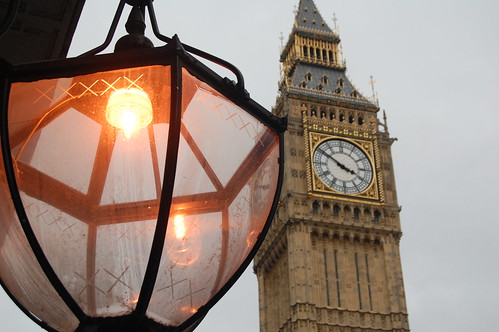
Stuffy, old, ornate buildings are everywhere. Where London gets interesting is its post-war housing complexes and brutalist council estates.
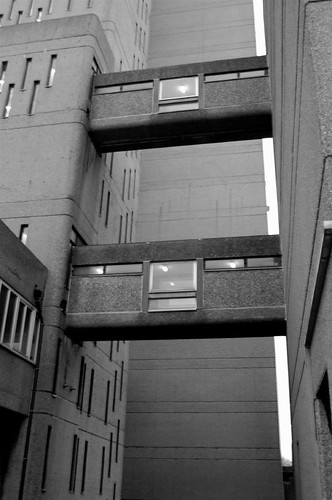
Featured in two of the photos above is the Trellick Tower in all its gorgeous brutalist glory. Between the first world's general Modernism backlash and Trellick's crime-ridden days of the 70s and 80s, the building was all but slated for demolition.
Trellick was regularly featured in the tabloids as “The Tower of Terror”, and there were stories of women being raped in the elevators, children attacked by drug addicts, and homeless squatters setting fire to empty flats. The underground garages were especially dangerous. Just before Christmas in 1972, vandals opened a fire hydrant on the 12th floor landing releasing thousands of gallons of water into the lift shafts and all heat and electricity was out for several days. - HousingPrototypes. org
The vertical concrete apocalypse that unfolds in JG Ballard's novel High Rise is said to be based on Trellick Tower. Despite, or maybe because of its reputation, in 1998 Trellick was finally designated a (Grade 2) landmark.
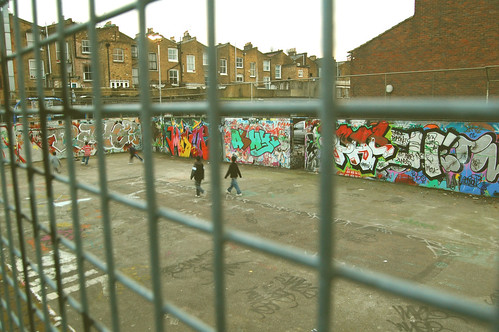
My heart leaped when the looming tower finally came into view. It rises above the neighborhood's sunken football pitches and Halal meat markets like a failed utopian dream.
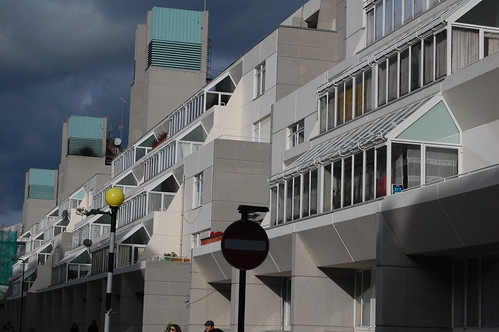
Despite the sameness in its early buildings, it seems London isn't scared of wacky new architecture. And extra credit for trying, but because of that you can walk through the city and say, "OMG that is so 90s!" Case in point- the contemporary architecture headache above where I imagine Jane's character from Coupling lives.
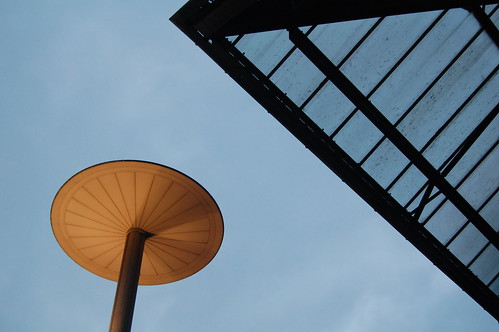
But then there's the little things, like the modern, mushroom-like lighting outside of classical Liverpool Street Station. It's beautiful, functional art. (You may recognize that station from this annoyingly awesome viral advertising video:
Man! I hate it that I love that ad so much.)
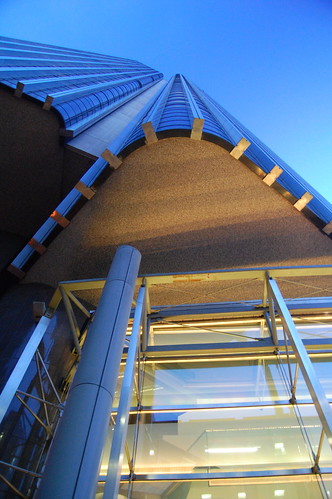
The tallest building in London is from the late 70s and has a bar at the top, irritatingly named "Vertigo". You wouldn't know from its skyline view, but, Tower 42 (formally Natwest) has a concrete core from which the 42 floors are cantilevered.
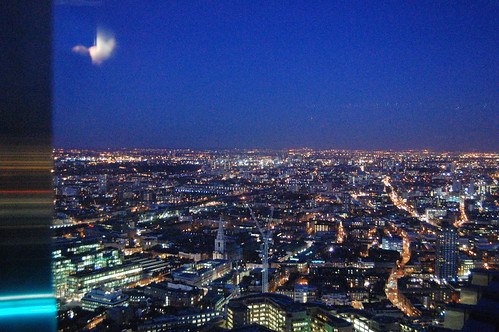
I highly recommend a drinking Pimm's Cup on the 42nd floor at dusk.

Upon realizing I was delusional for thinking I could afford anything in the shops on Brick Lane, we decided to sit in a cafe at the intersection of Ironic Tribal Poncho Street & Pete Doherty Lookalike Lane. For a moment I felt like Facehunter, covertly cataloging fashion that if worn outside of the big city art world would get your ass kicked, when some guy from California (of allll places) asks me if I'm "trend watching". Cause that's why he's in Shoreditch- Nike sent him! UGHHHHHHH.

Barbican Estate: the name itself is brutal. And it was built on top of a 40 acre hole in central London left by WWII bombs. The Barbican compound is (an extremely photogenic) car-free, poured-concrete work of art. It houses 4,000 people in 13 terrace blocks and three high rise residential buildings- still the tallest in London at 42 stories each. All of this on top of parking and a tube stop.
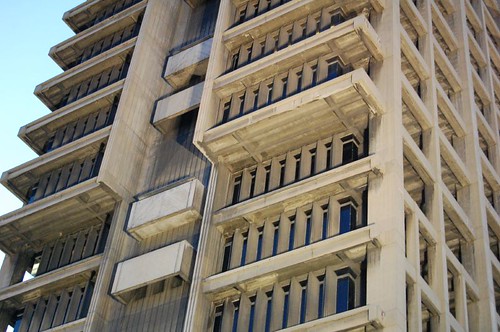
Having attended the University of Illinois at Chicago (University Hall pictured above), designed by the under-appreciated brutalist architect Walter Netsch, I felt right at home in Barbican. Though, the various plazas and exposed concrete lobbies made me a little panicky, is there a research paper I'm forgetting about!?
Since modernism and brutalism have fallen out of fashion (and then come somewhat back into fashion in the form of Herman Miller chairs and Haywood Wakefield desks via Mad Men), Barbican has recently been named a landmark. But it has also seen its share of modifications, like the arts and crafts style "embellishment" in the 1990s (that has since been removed) to the current repackaging as posh urban living today. Check out this glib description, aimed at what I can only assume are anti-social rich people, of Frobisher Court: barbicanliving.co.uk
I shouldn't complain- any trend to landmark and restore modern and brualist architecture instead of demolishing or mucking it up with whichever "humanist" (whatever that means) revival happens to be in style, is encouraging. Owen Hatherley, my new favorite modernist/author/blogger, explains why the middle and upper classes have the luxury of enjoying the most unpopular genre of modern architecture here:
Its flaw is that for Barbican residents a bit of the old ultraviolence is merely a breath of bracing air: yet if your existence involves plenty of struggle already, then living somewhere so aesthetically uncompromising could easily reinforce the petty brutalities of everyday life.
The beauty of sturdy, sculptural concrete, that shows age and wear and truth in its materials is that "breath of bracing air" us children of tacky postmodern malls crave. (Side note: our 1980s mall had an amazing food court with a multi-level seating area full of hidden coves and curving walls covered with thousands of tiny rectangular mirrors. And lots of neon.)
More depressing than a garbage strewn 60s-era plaza on a windy February day is the current architectural trajectory where the future doesn't look very futuristic at all.
I originally went to London for my first love: '91 breakbeat hardcore. And the old skool revival was in full swing by 1997. Thanks to our Chicago Brockout! connections, we club hopped VIP-style with the Suburban Base-bomber-jacket-wearing London Some'ting crew. We even watched Goldie make an ass of himself at some tiny underground bar. (Pic above: me and my late best friend Meaghan hanging out with original jungle innovator DJ Dextrous.)
It was under that dishwater colored sky (to borrow a term from Martin Amis) I realized the sheer necessity of the happy hardcore genre.

Centre Point's Soviet style fountain and pre-fab, pre-cast concrete project has been addled with problems since the beginning, but isn't it stunning? The delicate concrete fenestration at the base reminds me of One Woodward Avenue in Detroit (architect Minoru Yamasaki).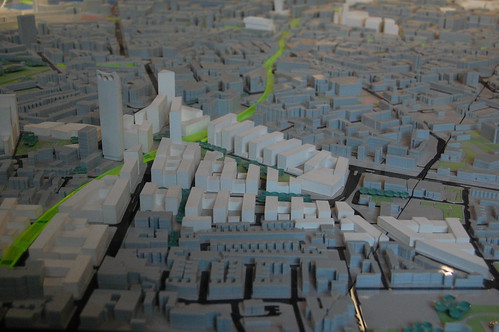
You can get a glimpse of all kinds of new, flashy projects at the NLA's scale model city. The buildings in white are proposed. The world will be watching for those projects to be realized in time for the 2012 summer olympics- that is if anyone watches them anymore. Didn't we JUST have the olympics!?
At the risk of sounding like a complete anglophile- Brits are undeniably the funniest people on earth. I want this blogger to be my London tour guide next time around: badbritisharchitecture.blogspot.com. Here's one of the nicer quotes from a post about a new institutional building:
Pick Everard aren't the worst architects in the world. In fact, I'd say that many of their employees are not out to deliberately fuck places up. However, these drawings are singularly hateful pieces of work.These drawings say: "Yes, I'm an architect, my father was an architect, and my architect wife and I will soon give birth to architect children. I can draw in this funny style, and as a result I have an overweening superiority complex. I think this complex comes from my undeniable dexterity at colouring in. I can also draw strange stick people in this style, and they are often accompanied by a child carrying a baloon. Clients enjoy these touches, despite the mockery the London elite lays on that kind of thing."
I'm off to watch Nevermind the Buzzcocks and pretend I get the British pop culture references.

No comments:
Post a Comment